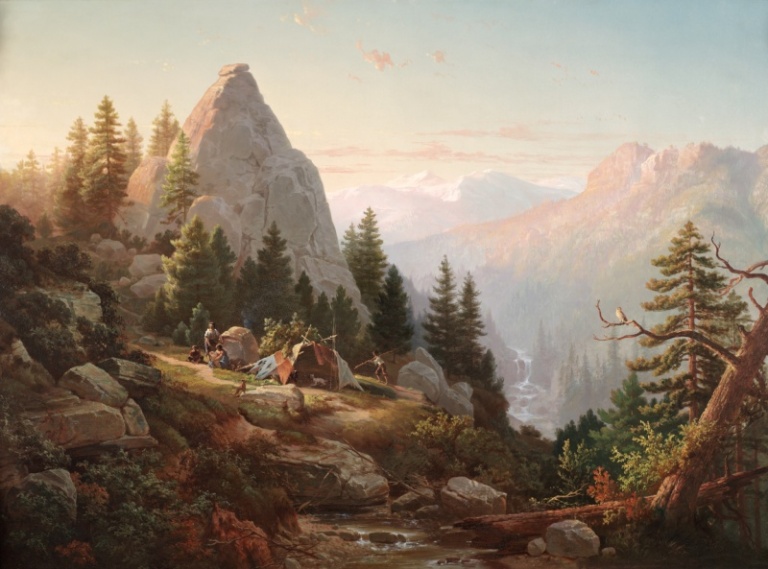By Sara Gorrell
When we first began working from home in March, I quickly added two things to my routine to make the stay-at-home order a little more bearable: I checked out a massive number of children’s books from the Sacramento Public Library, and I added a walk (sometimes two) to my routine. My growing interests in books and nature merged when I read the delightful children’s book Bird Count by Susan Edwards Richmond. The book follows Ava, a curious girl, her mother, and Big Al as they embark on their annual Christmas bird count to identify and record avian friends in their community.
Using my eyes and ears, I became inspired to look at and learn about birds in my own neighborhood. During the short time the Museum was open, I even journeyed on my own Crocker bird count. I wandered the galleries in search of birds in artwork. I discovered a lone owl in a Thomas Hill landscape and a variety of colorful birds in Tino Rodriguez's work. Then, on my way home, I marveled at the gaggle of geese at my local park.

Thomas Hill (American, born England, 1829–1908). Oil on canvas, 40 in. x 54 in. (101.6 cm x 137.16 cm). Crocker Art Museum, E. B. Crocker Collection, 1872.529.
(Can you find a bird in the painting above?)
During this holiday season, as many places in Sacramento (including the Museum) have closed again, I'd like to provide activities for families that bring joy. I'm no fowl expert, so I’ve invited our friends from Effie Yeaw Sacramento Nature Center to join us for a Birds of Prey program on Zoom. On Monday, December 21, we'll explore specimens and even see two birds of prey from Effie Yeaw’s classroom! Be sure to have a pencil and paper handy for sketching.
The fun continues Tuesday, December 22, when we release a sketching video with Crocker Educator Michelle Steen. Michelle will share her favorite backyard bird and walk you through tips for sketching your own.
We’ll end our flight on Wednesday, December 23 with children’s book author Susan Edwards Richmond. Susan will join us for two programs: At 11 AM, for How to Identify Birds, she’ll focus on our younger visitors (Pre-K – 1st grade). Using her book as a centerpiece, Richmond will introduce the essentials of bird habitat and identification while sharing the fun of counting. Later, at 2 PM, she’ll switch gears and offer a writing program for older birders (2nd – 5th grade) and share the inspiration behind her book, writing tips, and her journey as a children’s author. From close observation through revision, Susan will guide students in uncovering their own voices in the environment around them.
Continue the search on your own by downloading our printable Birder Art Sheet. Print out the worksheet or use it as a starting point for conversations about the birds you see in nature or artwork.
Wondering how to expand your adventure?
Flock to the Museum Store online to shop nature-and bird-themed activity books for the holidays. We’ll even have a few copies of Bird Count available for purchase!
Sara's tips for Birdwatching at Home:
- Start in your own backyard. For those that don’t have a backyard (like me), spend time looking out your window, or walk to a local park. If you’d like to explore birds in artwork, browse the Crocker’s collection to see if you can spot any!
- Use the Birder Art Sheet. Print out the bird worksheet or use it as a starting point for a conversation about the birds you see. If you and your family are beginner birders, don’t stress about identifying the bird you are looking at. Start by recognizing the field marks (the physical characteristics), talk about the bird's behavior, and listen to the sounds or calls they make.
- Explore online resources. The National Audubon Society has a fantastic website for kids here. It includes kid-friendly information, activities, and videos. Another great resource (especially for older kids or more experienced birders) is ebird. The website has more information on birds and allows you track bird lists, photos, or sounds! Take advantage of the website's search bar to look for types of birds that live in your region.
Top Image: Tino Rodriguez (American, born Mexico, 1965), Xochipilli's Ecstatic Universe, 2004. Oil on panel, 20 x 16 in. Crocker Art Museum purchase with contributions from Barbara and William Hyland, Monterey, California, and the George and Bea Gibson Fund, 2006.44.


